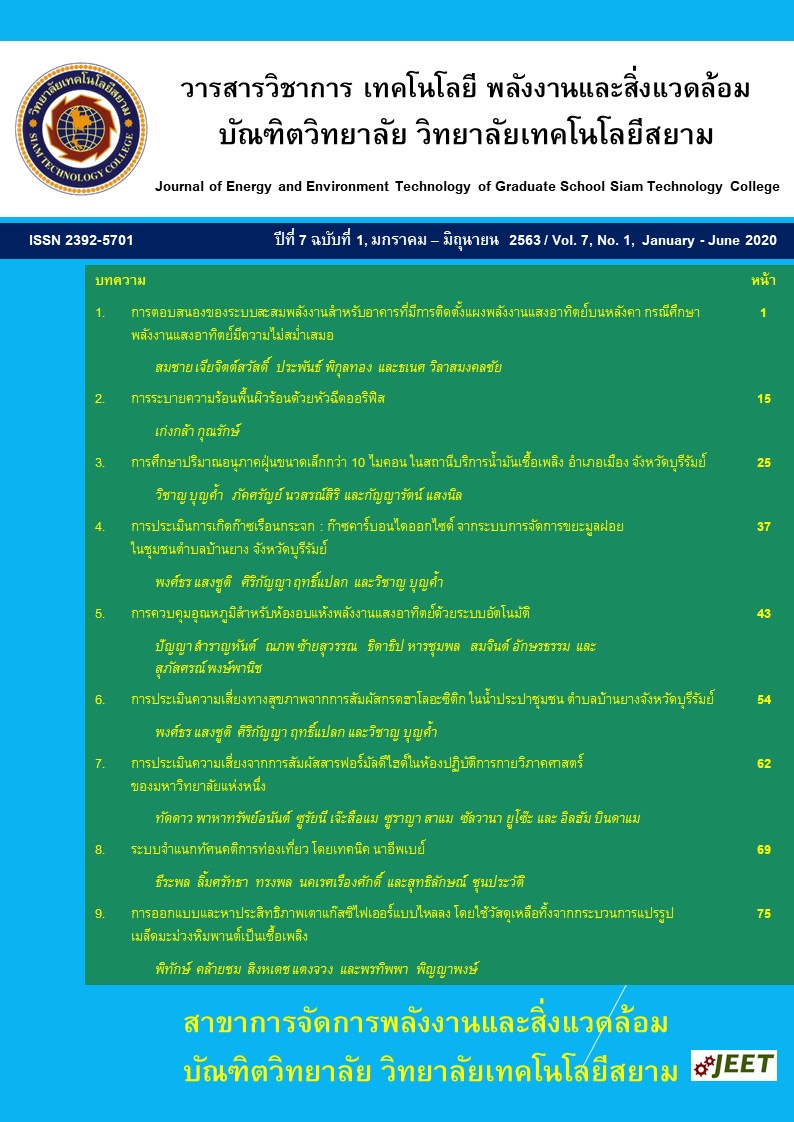THE ENERGY STORAGE SYSTEM RESPONSE ON THE SOLAR-ROOF BUILDING CASESTUDY: FLUCTUATED SOLAR POWER
Main Article Content
Abstract
Nowadays, there is not enough electrical energy to supply, Thailand government has issued policies to support renewable energy, such as solar roof-top to encourage the cooperation of the private sector to use renewable energy and setup as small-scale power plant. However, electrical energy generated from PV array affected by the solar fluctuation and make energy intermittent. The intermittent of environmental condition is the big problem of the using renewable energy, the forecast technology and monitoring system cannot manage for smoothing power as perfect. The reason is on the large number of solar-roof units would greatly reduce in cloudy condition. So, the use of energy storage system to solve the power fluctuation problem was necessary, but need to track the power changed instantaneously for the best in energy compensate. However, the highly fluctuated solar power and the rainy season has affected to the energy stored in batteries bank, then it cannot discharge to compensate perfectly. The priority based controlling scheme in this work shown the good result for solar power fluctuated and related scenarios.
Article Details
เนื้อหาและข่อมูลในบทความที่ลงตีพิมพ์ในวารสารวิชาการ เทคโนโลยี พลังงาน และสิ่งแวดล้อม บัณฑิตวิทยาลัย วิทยาลัยเทคโนโลยีสยาม ถือเป็นข้อคิดเห็นและความรับผิดชอบของผู้เขียนบทความโดยตรง ซึ่งกองบรรณาธิการวารสารไม่จำเป็นต้องเห็นด้วย หรือว่าร่วมรับผิดชอบใด ๆ
บทความ ข้อมูล เนื้อหา รูปภาพ ฯลฯ ที่ได้รับการตีพิมพ์ในวารสารวิชาการ เทคโนโลยี พลังงาน และสิ่งแวดล้อม บัณฑิตวิทยาลัย วิทยาลัยเทคโนโลยีสยาม ถือเป็นลิขสิทธิ์ของวารสารวิชาการ เทคโนโลยี พลังงาน และสิ่งแวดล้อม บัณฑิตวิทยาลัย วิทยาลัยเทคโนโลยีสยาม หากบุคคล หรือหน่วยงานใดต้องการนำทั้งหมด หรือส่วนหนึ่งส่วนใดไปเผยแพร่ต่อ หรือเพื่อกระทำการใด ๆ จะต้องได้รับอนุญาต เป็นลายลักษณ์อักษรจากวารสารวิชาการ เทคโนโลยี พลังงาน และสิ่งแวดล้อม บัณฑิตวิทยาลัย วิทยาลัยเทคโนโลยีสยาม เท่านั้น
References
ชัยวัฒน์ งามสมโสด, 2557, วิธีการลดขนาดพิกัดระบบเก็บพลังงานด้วยแบตเตอรี่ที่ใช้ร่วมกับระบบผลิตไฟฟ้าจากพลังงานแสงอาทิตย์, วิทยานิพนธ์ ปริญญาวิศวกรรมศาสตรมหาบัณฑิต-วิศวกรรมไฟฟ้า มหาวิทยาลัยเกษตรศาสตร์
Akatsuka,M., R. Hara, H. Kita, T. Ito, Y. Ueda, S. Miwa, N. Matsuno, K. Takitani and M. Saito, 2010, Suppression of Large-scaled PV Power Station Output Fluctuation using Sodium-Sulfur Battery. IEEJ Transaction on PE 130(2), pp. 223-231.
Sheikh, M.R.I., M.A. Motin, M.A. Hossain and M.Shahed. 2012. Reference Power Selection for Smoothing Wind Power Fluctuations with Reduced Energy Capacity. IEEE ICECE 2012, pp. 746-749.
Sadegh Shajari and Reza Key Pour, 2012, Reduction of Energy Storage System for Smoothing Hybrid wind-PV Power Fluctuation. IEEE EEEIC 2012, pp. 115-117.
Watanabe, R., Y.Ito, Y. Hida, R. Yokoyama, K. Iba and T. Tsukada., 2012. Optimal Capacity Selection of Hybrid Energy Storage Systems for Suppressing PV Output Fluctuation. IEEE PES ISGT ASIA 2012, pp. 1-5.
Alex Park and Petros Lappas, 2017. Evaluating demand charge reduction for commercial-scale solar PV coupled with battery storage. Renewable Energy 108, pp.523-532.
W.Srithiam, S.Asadamongkol, T.Sumranwanich, 2014. Application of Battery Energy Storage System in Coordination with MicroEMS for Mae Hong Son Microgrid during Islanding Mode. International Council on Large Electric Systems: AORC Technical meeting 2014.
F.A.T. Al-Saedi, 2013, Peak Shaving Energy Management System for Smart House, International Journal of Computer Science Engineering and Technology (IJCSET), Vol. 3, No. 10, pp. 359-366.


